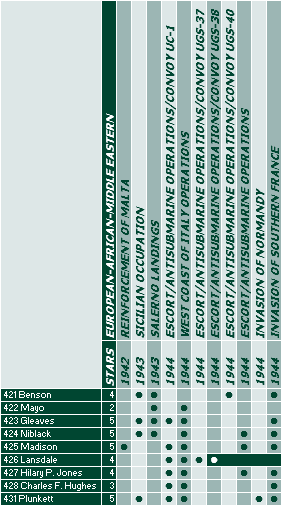
Destroyer Squadron 7
World War II Operations

The squadron already had a history. From September 1920–July 1922, it was composed of 15 flush-deckers in reserve at Charleston, South Carolina. In April 1939, it was reactivated at San Diego.
In June 1940, the six original 1,620-ton Benson-class destroyers and the first three concurrently-built 1,630-ton Gleaves-class ships began to commission. Gleaves (DD 423), built at Maine’s Bath Iron Works, was first, followed by Plunkett (DD 431) from Federal Shipyard & Drydock Co., Kearny, New Jersey, and Benson (DD 421) from Bethlehem Steel, Quincy Massachusetts in July. Gleaves-class Niblack (DD 424) from Bath and Benson-class Madison (DD 425) and Charles F. Hughes (DD 428) from Puget Sound Navy Yard, Hilary P. Jones (DD 427) from Charleston Navy Yard, Lansdale (DD 426) from Boston Navy Yard and Mayo (DD 422) from Quincy followed in September. In December, at Newport, Rhode Island, these ships were formed into Destroyer Squadron (DesRon) 7 with Plunkett as flagship.
From March 1941, under Capt. J. L. Kauffman (later ComDesPac), DesRon 7 operated “short-of-war” from Argentia, Newfoundland and Iceland with the flush-deckers of DesRons 30 and 31 in the Atlantic Convoy Support Force. On 10 April, while rescuing survivors of a Dutch cargo ship, DesDiv 13 flagship Niblack fired the first American depth charges of the war. On 31 October, she and Hilary P. Jones rescued the 45 survivors of flush-decker Reuben James, the first destroyer lost in the Atlantic. On 3 September 1942, these two plus Mayo and Madison with cruiser Brooklyn helped rescue more than 1,400 men from troopship Wakefield, which was later saved.
USS Plunkett (DD 431), flag
Like DesRons 11 and 13, composed of remaining ships from fiscal year 1939 and 1940 plus Bristol, DesRon 7 continued to serve in the Atlantic until the close of the invasion of Sicily, August 1943, when Plunkett and Gleaves accepted the surrender of the small island of Ustica.
The following month, Plunkett plus the four ships of DesDiv 13 operated in the screen of the Southern Attack Force during “Operation Avalanche,” the invasion of Italy. On 9 October, Gleaves and a British LCT rescued 57 survivors when DesRon 13 flagship Buck was torpedoed and sunk in the Gulf of Salerno.
The full squadron less Benson operated with RAdm. F.J. Lowry’s multinational Task Force 81 in “Operation Shingle,” the landings at Anzio, which followed in January 1944. While providing fire support, Mayo succeeded in breaking up a German counterattack 23 January, the day before she was damaged by an underwater explosion.
That same day, 24 January, Plunkett suffered major damage from a bomb hit and was later awarded the Navy Unit Commendaton for her combat efficiency and effective damage control on this occasion. Repaired, she went to Normandy for the D-day invasion in June and took part in the bombardment of Cherbourg, 25 June, before rejoining the squadron in the Mediterranean Sea.
Meanwhile, off Algeria in April, Lansdale was torpedoed and sunk by German bombers. On 14 May, Gleaves and Hilary P. Jones were two of eight destroyers that, with British aircraft, sank U-616 off Spain but rescued 53 members of her crew in an extended action later called “Operation Monstrous.” A week later, Niblack and Ludlow sank U-960 with gunfire.
In August, less Mayo (which was still under repair at New York), the squadron participated in “Operation Anvil,” the invasion of Southern France. There, into September, they engaged in shore bombardment while battling small torpedo craft and human torpedoes. Off San Remo and nearby Porto Maurizio, Italy, in the Allies’ last naval action in the Mediterranean, Hilary P. Jones distinguished herself and became, with Woolsey, one of only two destroyers awarded a Navy Unit Commendaton prompted by shore bombardment performance.
Convoy duty and overhaul followed. Then, in spring 1945, the squadron was transferred to the Pacific, where it remained through the end of the war. Benson, Mayo, Madison and Hilary P. Jones entered Tokyo Bay 2 September during the surrender ceremony. Returning home, DesRon 7 was deactivated in November and all ships were decommissioned the following year.
In 1954, Benson and Hilary P. Jones went to Taiwan where they served as Lo Yang and Han Yang, respectively. Plunkett followed in 1959 as Nan Yang.
Final disposition came slowly: Madison and Charles F. Hughes were sunk as targets in 1969. Mayo and Gleaves were scrapped in 1972; Niblack in 1973. The three Taiwanese ships were the last to be stricken, in 1974.